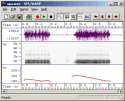| Home | Overview | Documentation | Download | MATLAB API | HowTo... | FAQ | Feedback |

SFS How-To Guides
1. How to use SFS to transcribe speech signals
This how-to guide provides a tutorial introduction to the use of SFS for the orthographic and phonetic transcription of a speech recording, including tools for automatic alignment of phonetic transcription to the signal. This tutorial refers to versions 4.6 and later of SFS.
2. How to use SFS for formant analysis
This how-to guide provides a tutorial introduction to the use of SFS for the analysis of the phonetic properties of speech based on measurements of formant frequencies. The tutorial demonstrates how to annotate the signal, how to perform formant analysis, how to extract formant frequencies and how to analyse the resulting data sets. This tutorial refers to versions 4.6 and later of SFS.
3. How to use SFS with the HTK Hidden Markov modelling toolkit
This how-to guide provides a tutorial introduction to the use of SFS in combination with the Cambridge Hidden Markov modelling toolkit (HTK) for pattern processing of speech signals. The tutorial covers installation, file conversion, phone and phone-class recognition, phonetic alignment and pronunciation variation analysis. This tutorial refers to versions 4.6 and later of SFS with version 3.3 of HTK.


